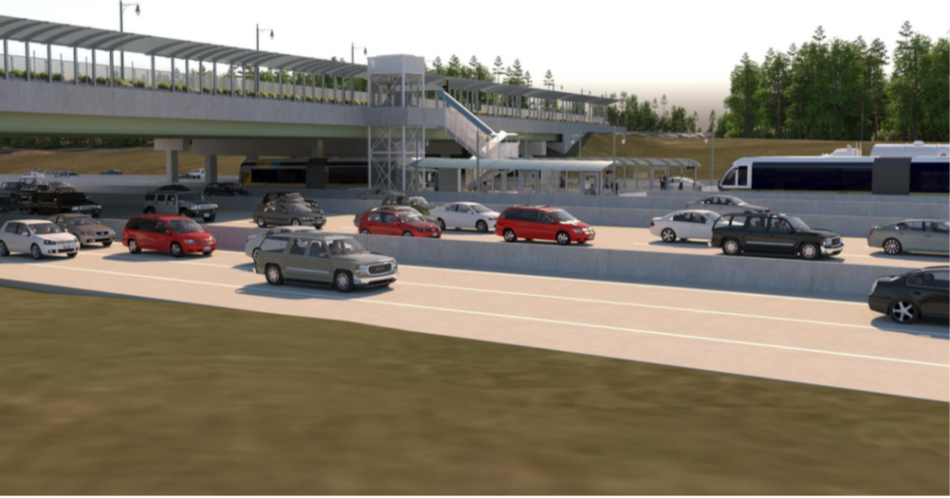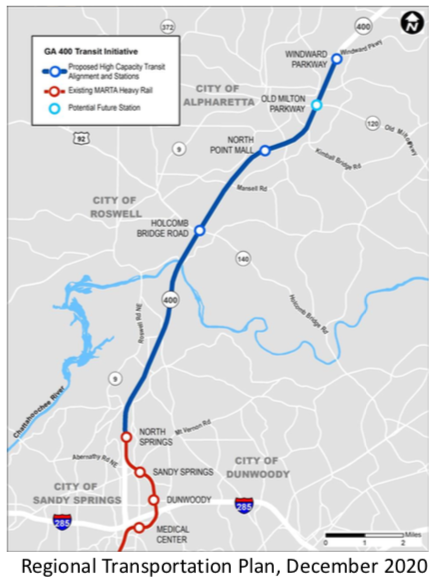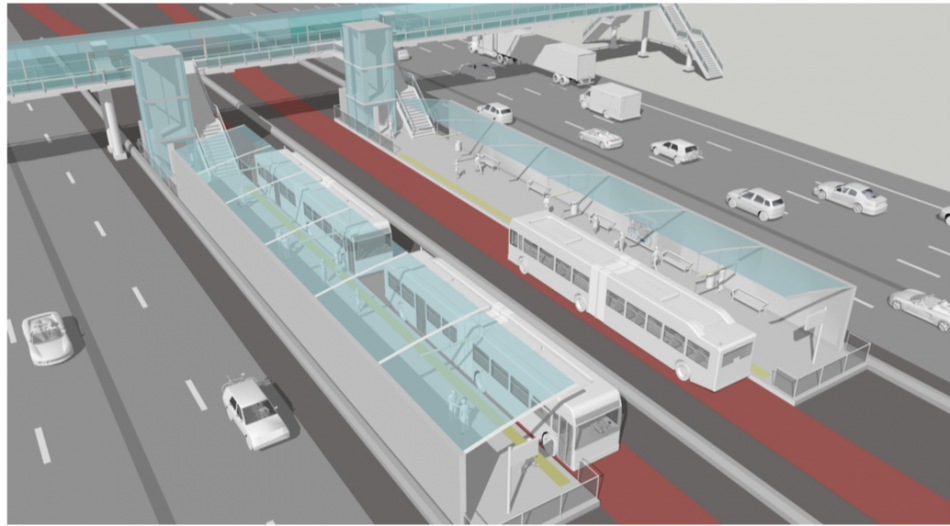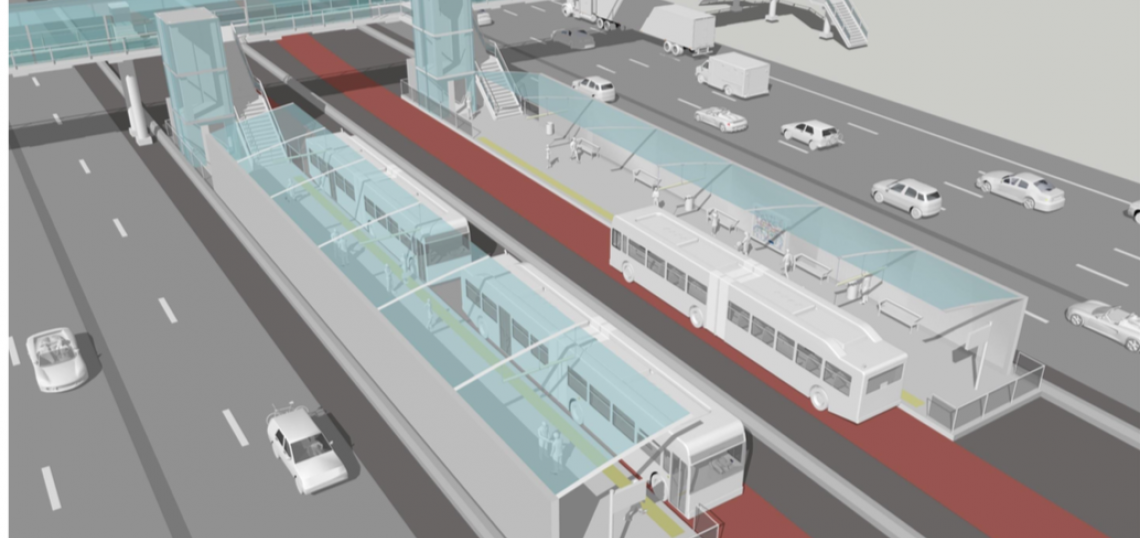In a perfect world for MARTA, the Georgia Department of Transportation’s express lanes project on Ga. Highway 400 will open in about six years with efficient bus stops in the middle of highway lanes, dotted from Sandy Springs to the northern reaches of Alpharetta, offering transportation alternatives to thousands of commuters daily.
Exactly how those bus rapid transit, or BRT, stations would be paid for is where questions linger.
MARTA officials laid out their concepts for one such station at Holcomb Bridge Road earlier this month during a work session with Roswell government leaders, including Mayor Lori Henry and city councilmembers.
 Potential look of the Holcomb Bridge Road stop. Courtesy of MARTA
Potential look of the Holcomb Bridge Road stop. Courtesy of MARTA
That BRT station would cost between $35 and $44 million across two phases, MARTA officials estimate. They came before Roswell dignitaries, in sales pitch mode, suggesting “value capture” sources of revenue, such as a new tax allocation district, that might be used to foot that bill as an alternative to TSPLOST funding or (gasp) additional taxes on Roswell’s citizenry.
MARTA’s broader goal is to take advantage of the billion-dollar investment GDOT is making to build about 16 miles of express lanes up Ga. Highway 400 as part of the agency’s Major Mobility Investment Program, which will also see express lanes installed on Interstate 285.
 Where bus stations would be built, beginning at MARTA's North Springs transit hub. Courtesy of MARTA
Where bus stations would be built, beginning at MARTA's North Springs transit hub. Courtesy of MARTA
Plans on Ga. Highway 400 call for four new express lanes—two heading north, the others south.
Ultimately, MARTA hopes to build five BRT stations, with stops at North Springs, Holcomb Bridge Road, North Point Mall, Old Milton Parkway, and Windward Parkway in Alpharetta, near Cumming. Total costs could exceed $176 million.
 Concept for the Holcomb Bridge Road stop's platforms within express lanes. Courtesy of MARTA
Concept for the Holcomb Bridge Road stop's platforms within express lanes. Courtesy of MARTA
In addition to TAD funding, MARTA suggests municipalities could create a Special Service District, similar to what the Atlanta BeltLine is now establishing to finish building the 22-mile loop, and ground lease revenue bonds to make BRT stations a reality.
“I think it’s a really important story for the region,” Colleen Kiernan, MARTA’s senior director of government and community affairs, wrote to Urbanize Atlanta in an email. “I think the larger theme is that our region is overly reliant on sales tax to fund transit, and successful use of one or more of these new avenues could be really impactful.”
A deal in 2018 that established the regional Atlanta Transit Link Authority allowed Fulton and DeKalb counties to levy additional funds to support transit expansion. (Also included: $100 million in state bond funding for Ga. Highway 400 projects.) The arrangement went that Fulton County would use this new tool—a $.002, 30-year transit referendum—to raise enough cash to complete transit projects along Ga. Highway 400, with MARTA covering operations and maintenance with an existing penny sales tax.
But as Kiernan noted, “Fulton County and the mayors of Fulton County have not come to anything close to an agreement to move forward with the transit sales tax, or to dedicate a portion of their TSPLOST proceeds for transit projects.”
Which brings us to the Roswell session on March 8.
Roswell councilmember Mike Palermo said the area MARTA had identified for TAD funding is “definitely the right quadrant” of the highway’s intersection with Holcomb Bridge Road. “There’s been a lot of calls for public safety service and frankly crime [in the area] that I think this council needs to address more,” said Palermo at the meeting.
Another councilmember expressed his wishes to see federal funding that MARTA’s set to receive as part of coronavirus aid packages—that “big old pile of money [from] our friends in D.C.”—spent on BRT initiatives.
But the emergency aid dough doesn’t seem likely to fund new projects.
Since last March, MARTA has pulled in more than $331 million in federal aid meant to stabilize the agency during the pandemic. All surplus funding—expected to reach $272.5 million at the end of fiscal 2021—will help offset potential deficits through 2025, “giving the economy and ridership time to recover,” according to MARTA officials.
Meanwhile, GDOT is expected to select a contractor for the Ga. Highway 400 express lanes project in September, with expectations of opening the lanes in the first quarter of 2027, Kiernan said.
“Without funding to build the stations, the project will be built ‘not to preclude transit,’” she noted. MARTA’s current bus route 143, which serves between North Springs and the Windward Park & Ride stations, would still run in the express lanes, said Kiernan, but “it just won’t stop” without funding for stations.
• Could a MARTA rail expansion to (almost) Cobb County be brewing? (Urbanize Atlanta)
• MARTA scores $284M in latest round of COVID-19 rescue funds (Urbanize)






